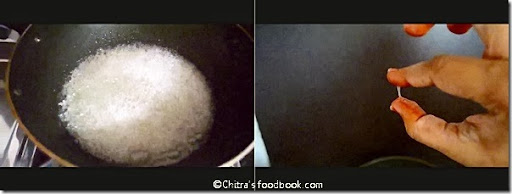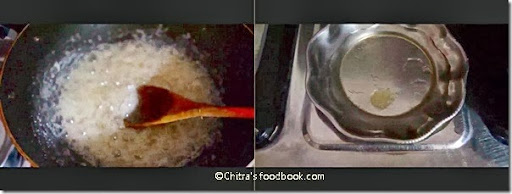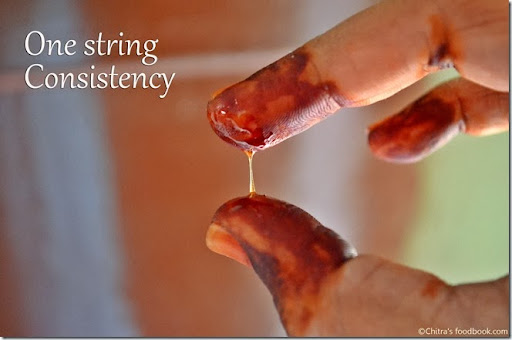| Take the required amount of sugar in a bowl/kadai and add water to cover the sugar. Here I used 1 cup of sugar and 1/2 cup of water . Beginners, always keep the flame low while making sugar syrup else you may miss the right stage. Similarly its always better to switch off the flame while you test the syrup in your fingers. If it boils, it may quickly go the next stage and cheat you.

THIN SYRUP : This is the first stage. The sugar dissolves completely, clears & it gets a shine. After removing the scum , the syrup boils and gets a shine. In this stage the syrup wont be sticky just shiny .This stage is not required for any sweets. So it is not much important. For beginners, keep the flame low always.
STICKY SYRUP : This is the second stage. Here the sugar syrup becomes little thick.Take little syrup in a ladle and touch it with ur fore finger. When you slide the thumb over fore finger , it feels sticky. This is used for Gulab jamun.
HALF – STRING CONSISTENCY Its always better to switch off the flame while you test the syrup in your fingers. If it boils, it may quickly go the next stage and cheat you. In this stage , when you test between ur thumb and fore finger , it strings & cuts off immediately. This syrup is used for jangiri, jelabi , Kajas, gulgul. Some people say sticky & half string consistencies are similar. So both can be used to make gulab jamun. In the below picture, hope you can see the string is cutting when I stretch it.

ONE- STRING CONSISTENCY
This is the most important stage. Here a thin long string is formed up to 1- 2 inches when tested in between thumb and fore finger. One more way to check the syrup is : pour the syrup in a small plate with water. It wont dissolve immediately and when you try to gather the syrup, it will be dissolved. Also when you pour the syrup in a ladle, the last drop falls slowly and forms a small string. Kaju katli, badam burfi , Thosha , badushah, mysore pak are made in this syrup. Refer the cover picture too. Its always better to switch off the flame while you test the syrup in your fingers. If it boils, it may quickly go the next stage and cheat you.

TWO STRING CONSISTENCY Two strings are formed when tested between fingers. Generally this syrup crystallizes very soon . So sweets which require a sugar coated look need this consistency. cashew burfi ,boondi ladoo, mohanthal is made in this consistency..

THREE STRING CONSISTENCY
Here string becomes thicker and when tested , string is formed in 2, 3 places. Dhal burfi requires this syrup. Sugar crystallizes very soon in this stage.
GATHERING CONSISTENCY
Pour little syrup in water, it can be gathered using ur fingers but you can;t make a ball. It is required for some burfis and boondi ladoo can also be made in this consistency.

SOFT BALL CONSISTENCY
Pour a small amount of syrup in a plate of water. If rolled with fingers, syrup should form a small ball in the water itself.. You can take and make a soft ball out of it. It is called as thakkali padham in tamil. This is used for adhirasam.

HARD BALL CONSISTENCY
When u pour syrup into the water & roll it , you should be able to make a ball and if you drop the ball, you’ll get a “tung” sound. The color of the ball is changed. This is used to make peanut chikkis/ kadalai mittai and pori urundai. I tested the sound by dropping it in the plate.

The remaining stages are soft crack , hard crack & golden brown caramel ( last stage). Brown caramel stage is required for making Tirunelveli halwa recipe. So I have shared about this in that post. As we don’t need them for making many sweets, I have not discussed here. They are used for making toffees.
|
![]()
















Leave a Reply